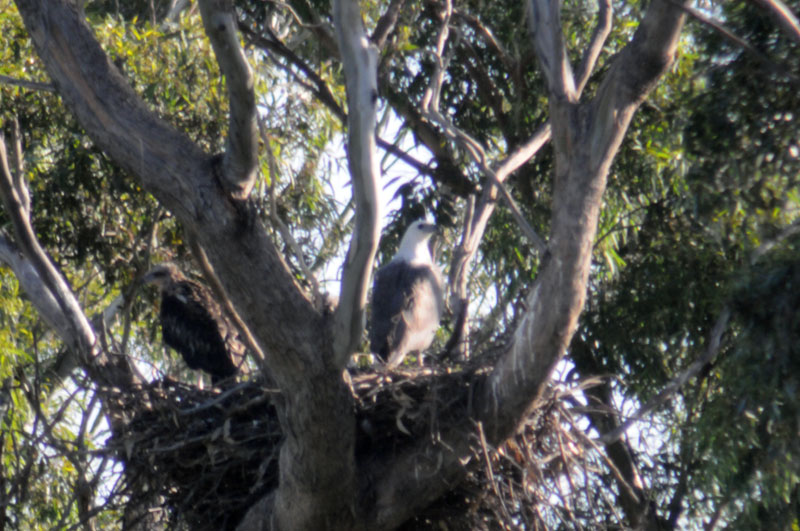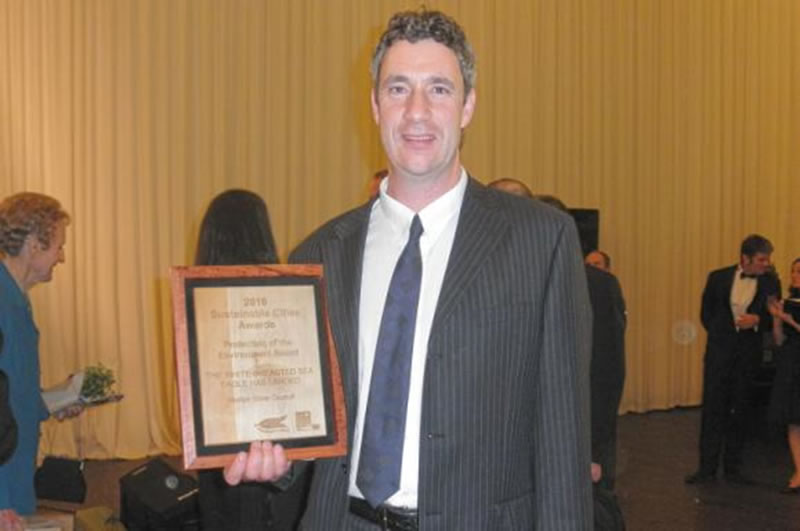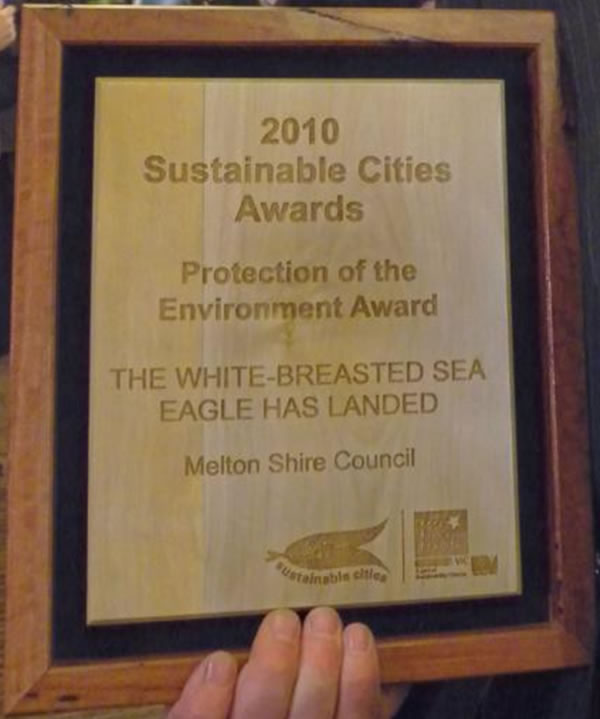Pinkerton Landcare and Environment Group and Western Water are proud that a pair of rare White-bellied Sea-Eagles have made Pinkerton Forest their home.
One of our most striking birds is the White-bellied Sea-eagle. These magnificent birds are frequently seen in advertisements for Kakadu and flying over other exotic landscapes in northern Australia, but several of these large black and white eagles can be found in our own neighbourhood. They are frequently seen flying over the Werribee River at Exford, the treatment ponds at Surbiton Park, Melton Reservoir and Lake Merrimu. The Sea-Eagle is similar to the Wedge-tailed Eagle, but has striking black and white coloration, and no long wedge-shaped tail. However, when they are seen from above, instead of the dramatic black and white coloration, the back of its broad wings are a soft grey colour. This sometimes occurs when standing on the escarpment overlooking the reservoir and the Sea-Eagles can be seen flying low over the water, far below. These eagles feed on fish and waterbirds.
The juvenile bird is not so boldy coloured as the adult birds, being mainly a brown colour. These magnificent birds breed locally. The presence of these magnificent Sea-Eagles makes the Werribee River unique in the western region.
Sea-Eagle Diary
In 2009 a pair of threatened White-bellied Sea-Eagles was discovered nesting in Pinkerton Forest.
Sea-Eagles have for several years been observed flying and fishing along the Werribee River, the adjacent Western Water sewerage treatment ponds and nearby Melton Reservoir. The White-bellied Sea-Eagle is similar to a Wedge-tailed Eagle, but has striking black and white coloration, and no long wedge-shaped tail.
In early August 2009 two Sea-Eagles were observed resting in separate trees in Upper Pinkerton during the August quarterly survey by Bird Observation and Conservation Australia (BOCA). BOCA conduct quarterly bird surveys in Pinkerton Forest and Bush’s paddock, monitoring diversity of bird species (especially noting endangered species).
In late August 2009 while burning boxthorns, PLEG members observed a Sea-Eagle and a Wedge-tailed Eagle involved in a long aerial battle over Upper Pinkerton. The Sea-Eagle was very vocal, ‘honking’ frequently.
On Sunday 1st September 2009 a Sea-Eagle nest was discovered in a Grey Box tree in Upper Pinkerton by Peter Gibbon and Brett Whitfield while GPS mapping Grey Box saplings.
Steps were immediately taken to ensure the successful nesting of these magnificent but threatened birds:
- As soon as the Sea-Eagle nest was discovered PLEG member Peter Gibbons (a BOCA member with considerable bird expertise) immediately researched what was known of Sea-Eagle nesting
- Peter’s research showed that Sea-Eagles are extremely sensitive to human disturbance and will abandon eggs and chicks if disturbed. Peter immediately cordoned off the site, creating a ‘no-go exclusion zone’ around the nest
- This exclusion zone was established in line with recommendations from other parts of Australia, that the exclusion zone be at least 500 metres to 2 kilometres from the nest. Stephen Debus BA, Dip Natural Resources (Wildlife) Dip Ed. MSC (Zoology) PhD (Zoology) Pers Comm 2011
- Management practices and weeding in this zone were postponed until after successful breeding was completed. Only entry/access deemed completely necessary within this zone was allowed during the Sea-Eagles breeding cycle.
- Wedge-tailed Eagles nested successfully here in 2007, creating major coverage in the local media and much community attention
- It was decided that similar attention to the more sensitive Sea-Eagles could be harmful to their potential breeding success
- News about the Sea-Eagles nesting was embargoed until after fledging of the two young birds as an event of this sort would excite much attention, possibly resulting in unauthorized intrusive visits
- Local bird photographer and PLEG member Nora Peters was requested to monitor and chronicle the raising of the Sea-Eagle chicks, as knowledge about Sea-Eagles nesting is limited
- Nora’s photographs have resulted in a beautiful portfolio of the nesting activities of the White-bellied Sea-Eagles.
- This portfolio will greatly enhance knowledge of Sea-Eagles’ nesting
- The portfolio is also of great value in enhancing local community awareness of the importance in maintaining valuable woodland remnants such as Pinkerton forest
- Long-range photography was a challenge due to the ‘no-go exclusion zone’ around the nest site
- A nearby dam (maintained for irrigation purposes) ensured a constant supply of food for the eagle chicks
Western Water maintains the level of water in a nearby large dam on the southeast edge of Pinkerton Forest.
- This dam has become a valuable wetland that attracts large numbers of waterbirds
- It had become of great value as a wildlife drought refuge.
- Vulnerable birds such as Australasian Shovelers and Lathams Snipe are among the many bird species, including various migratory species, attracted to this wetland.
- Breeding ducks on the dam formed a regular food supply for the nesting Sea-Eagles, no doubt contributing to the successful raising of two chicks.
Over the next couple of months the Sea-Eagles were observed and photographed discreetly by Nora Peters.
In November 2009 Nora photographed the two adults and a chick at the nest. The eagles were observed taking food from various areas and taking it to the nest. By January the young Sea-Eagles were flying freely, but still being fed by the adult birds. Nora was able to distinguish between the two young birds as they were different in both size and colour.
In early January 2010 the Sea-Eagles are still active at the site around Pinkerton Forest and the dam. On one occasion we saw the juvenile and an adult in the trees beside the dam. While we were there an adult bird brought food to the juvenile twice. The dam was greatly reduced in area due to the hot weather, with several Grey and Chestnut Teal, and numerous ducklings. The adult first brought a bird in its talons to the young bird. It circled around for nearly five minutes before actually descending to the trees to feed the young bird, possibly uneasy at our presence. The young bird greeted it with a raucous, almost cackling honking, not like the deep honking call of the adults. An hour later the adult bird was observed swooping low over the dam, creating mayhem among the waterbirds. It was soon circling high over the trees once more, again with a bird in its talons, possibly a duckling. The ducks on the dam must be providing a ready food source. The proverbial sitting ducks! Again, it circled overhead for about five minutes before descending to the trees. A Whistling Kite was showing considerable interest in the activity, perhaps a cause for the adult bird’s caution in not immediately approaching the juvenile. The kite may have been interested in scavenging food from the young bird.
Usually one young bird survives to adulthood. The group is therefore justifiably proud that both young birds survived to become freely flying juveniles, easily recognized by their brown colouration (in contrast to the bold black and white plumage of the adults).

Juvenile and adult Sea-Eagles on nest in Pinkerton Forest
2010
In 2010 the Sea-Eagles returned once again to the Pinkerton nest, this time successfully rearing one fledgling
-pleg-20-3-10.jpg)
Juvenile Sea-Eagle flying over Pinkerton Forest (photo by Peter Gregory)
Legal protection status of White-bellied Sea-eagle
White-bellied Sea-Eagles are listed under Australian and State Government legislation and international conventions, as follows:
National: Listed as Marine and Migratory under the Environment Protection and Biodiversity Conservation Act 1999.
Victoria: Listed as Threatened under the Flora and Fauna Guarantee Act 1988, and as Vulnerable under the Advisory List of Threatened Vertebrate Fauna in Victoria 2003.
CITES: Listed under Appendix II of the Convention on International in Endangered Species of Wild Fauna and Flora (CITES) (CITES 2005).
CAMBA: Listed under the China-Australia Migratory Bird Agreement (CAMBA) (Australian Legal Information Institute 2005).
The White-bellied Sea-Eagle is listed as a migratory species under the Federal Environment Protection and Biodiversity Conservation Act and listed as threatened under the Victorian Flora and Fauna Guarantee Act.
These birds are declining in numbers and our own local Sea-Eagles are deserving of our protection.
2010Sustainability Cities and Keep Australia Beautiful Victoria awards:
Protection of the Environment Award
The significance of this event was recognized by the Sustainability Cities and Keep Australia Beautiful Victoria awards in 2010.
Melton won the prestigious 2010 Sustainability Cities and Keep Australia Beautiful Victoria Protection of the Environment Award:
‘The White-Breasted Sea Eagle has landed’
“Members of the Pinkerton Landcare and Environment Group take care of the endangered grasslands and woodlands in the Melton/Werribee area. This included Bush’s Paddock, Pinkerton Forest, Werribee River Volcanic Gorge and Ferris Road Rail Reserve. As part of their work the group protected the nest of a pair of sea eagles in Pinkerton Forest. The pair successfully reared 2 fledglings, and the event as photographed and displayed at meeting attended by local bird enthusiasts.”

PLEG President Richard Rowe with Protection of the Environment Award (photo by Nora Peters)

2011
On Saturday 21st May 2011 while spraying serrated tussock PLEG members (Frances Overmars and Daryl Akers) observed the Sea-Eagle circling around us and the nest tree. It was harassed by several crows and a Brown Falcon but it remained in the area. After circling around for some time it landed in the nest tree and remained there. At this point we left the nest area.
June 2011
The Sea-Eagles have once again returned to their nest site which is deemed to be an active site in Pinkerton Forest. We confidently expect that the Sea-Eagles will once again raise young successfully. The same protection measures that were undertaken in 2009 and 2010 are currently in place at Pinkerton Forest to ensure every chance of another successful breeding cycle.
